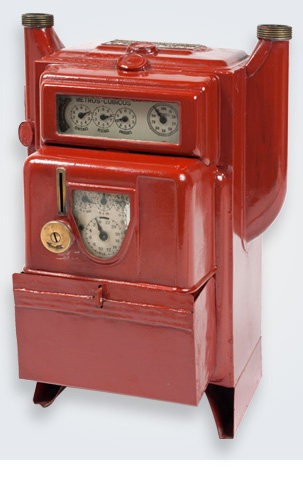
Contador de gas
Polychrome iron in red colorEarly XX century
Made in Kromschroeder, S.A.
MG-2709 / CN-11
This is an example of a paid gas meter from the early 20th century. You can find this gas meter in the cabinet of floor -1 at the Gas Natural Fenosa Foundation Gas Museum, where it is permanently exhibited.
Gas meters have evolved throughout the history of gas and there are two types. Factory meters, that provided a graphic of the gas production every 24 hours through a recording mechanism that marked the increases and reductions of production; and the paid meters, that indicated the user’s daily consumption at home and helped the supplier to charge. The meter displayed in the image belongs to this second type of meter.
Before these meters, consumption was measured by the size of the flame and the duration of the street lighting. That is, the approximate volume that the lighter could use was measured.
In 1815, to resolve this issue, Samuel Clegg introduced and installed a device made of two bells that were filled and emptied alternately, meaning the gas consumption was clear. Este modelo fue evolucionando gracias a las investigaciones y aportaciones de Malam, Crosley, Warner-Corvan, This model was developed thanks to research and contributions from Malam, Crosley, Warner-Corvan, Siry Lizars and others, leading to new types of paid meter being launched on the market: hydraulic meters, oil meters and dry meters.
The meter displayed in the image is a dry meter. This type of meter measured the gas with two bellows that were filled and emptied alternately.
The gas pressure produced a circular movement with support from some levers that moved the set of gears in the recording device.
The inventor of this meter is understood to be a labourer called Bogardus, but it was patented by Berry in 1833.
One of the advantages of this meter was that it did not have the levelling issue that wet meters had and it did not freeze in cold temperatures, leading it to be used in cold countries, where it improved but, ultimately, did not have the success that was expected.
The feature of this meter we are exhibiting is that it is a pre-payment meter. This mechanism enabled the subscriber to receive gas by putting money in the meter. The gate valve opened when the consumer inserted money, leaving the entrance open for gas. The amount of gas available depended on the amount of money inserted. The meters made it easy for consumers to use gas, whereas before it was difficult to pay monthly or people were unable to leave the security deposit required for other types of meter.
*Bibliografía:
Alayo, J.Carles y Barca, Francesc X., La tecnología del gas a través de su historia; edición de Fundación Gas Natural Fenosa , LID editorial , 2011.